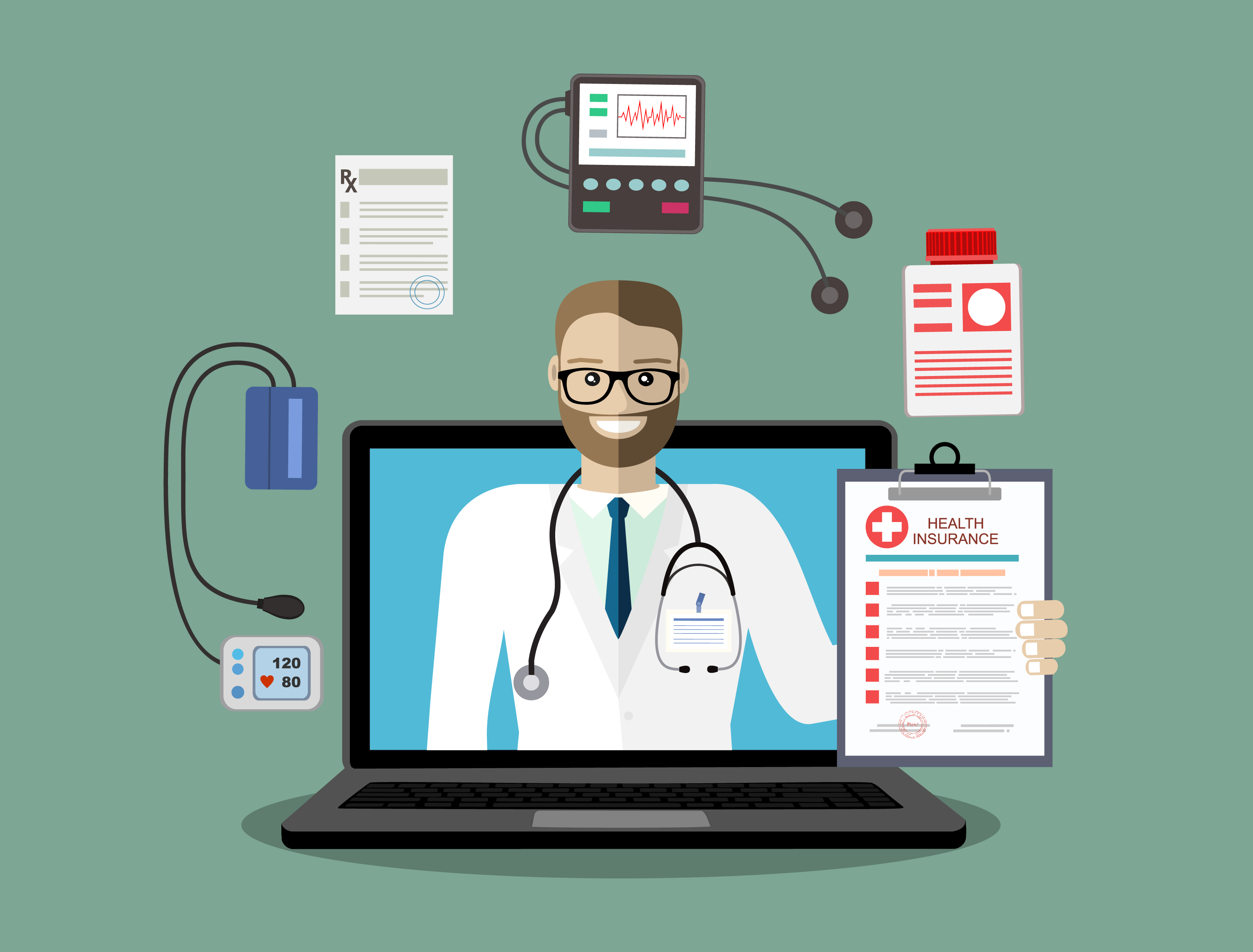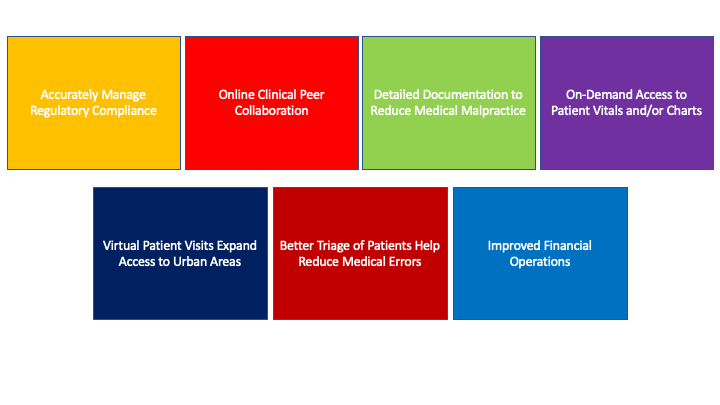
Telehealth is Driving Today's Medical Superhighway
Over the past few decades, healthcare, medical research, and clinical treatments
have emphasized an overwhelming reliance on technology to design life-altering
solutions. The resulting outcomes have helped improve patients' overall quality
of life and reduce fatalities for many throughout the world.
During the
recent global pandemic, time, communications, and data sharing have altered
treatments and saved lives. Outside those types of catastrophic circumstances,
the role of telehealth and telemedicine in our daily lives has become far more
of an assumption that – with technology - there is an answer to nearly
everything, or it is around the corner.
Is There a Difference Between Telehealth and Telemedicine?
According to the HRSA, telehealth is defined as "the use of electronic
information and telecommunication technologies to support and promote
long-distance clinical health care, patient and professional health-related
education, public health and health administration.* (Telehealth can
occasionally be referred to as e-health (electronic health) or m-health (mobile
health.))
Whereas telemedicine is a subset of telehealth, but with a more
limited scope, it uses electronic communications and software to allow for a
range of remote clinical services. Through telemedicine, healthcare providers
can evaluate, diagnose and treat patients often without the need for an
in-person visit.
What telehealth solutions are profoundly changing
medicine today? How are liability and other risks addressed?
Health Care Teams and Patients – Cautious Adopters to Technologies
Although often skeptical about significant changes in the medical environment,
medical practices, hospitals, and research facilities have become strong
advocates given various digital support solutions. They're seeing that it allows
them to be more proactive and responsive to patient care.
Telehealth
digital solutions and technologies have helped expedite information sharing,
improve safety, reduce medical errors, and much more. And as on-demand
information is now generally expected in our fast-paced lives, aspects of
"touchpoint health" solutions have enhanced the patient experience.
With
direct access to their medical records, health history, test results, etc.,
patient satisfaction has soared with the convenience of a mobile-friendly format
and 24/7 access. When time is critical for assessing urgent care issues or
managing chronic medical conditions, telemedicine has transitioned the concept
of the old-school house call to the "virtual visits" connecting patients and
doctors via online sessions.
Using advanced, interactive platforms, they
can discuss any issues and next steps via digital chats. These advancements have
been incredibly beneficial for rural areas with limited access to quality care.
In most cases, telehealth is a lifesaver.
New Medical Technologies Saving Patient Lives
The continual evolution of digital health innovations has become undeniable with greater efficacy and even FDA approvals in some areas.
- Virtual Visits: Many non-urgent and chronic disease management patient care "visits" have been seamlessly conducted via virtual online visits. In a click, patient care issues can be identified, treated, and administered to promptly and consistently. And to answer the bigger question, yes, these new consultations are now covered by most insurance companies.**
- Mobile-Friendly Patient Care: With people "living" in a mobile, fast-paced environment these days, they expect to have more options at their fingertips. Some FDA-approved mobile applications/devices allow you to take a lab-quality electrocardiogram (EKG) within a minute, save your results, add verbal or text notes, and send it to your doctors for less than $200. Other low-cost health monitoring devices allow patients to track their heart rates and blood oxygen saturation levels (commonly known as pulse oximetry or pulse ox) remotely.
The convenience of other patient-facing mobile solutions has altered perspectives
about what could be medically approved but managed outside of a clinical
environment.
Identify Your Barriers and Find Reasons to Adjust Your Perspectives
Is all this necessary? And why would medical teams in hospitals, clinics, and
research facilities prioritize telehealth ahead of new medical and surgical
treatment technologies? Telehealth is not about prioritizing one aspect over
another; it is critical to actively stay informed and implement transformational
technologies as needed in all medical arenas.
Many of the top reasons
include:
- Patient safety
- Accuracy in clinical documentation
- Expedited testing results
- Reduced processing time, coding errors, denials in billing and reimbursement issues
- Improved patient engagement, communications, and convenience
- Decreased medical errors and liability
- Improved quality of healthcare delivery
- A simple means of access to medical test results, supplemental clinical team collaborations, etc.
Of course, some of the most significant barriers focus on finances and logistics.
Given medical resources and staff shortages, there are often concerns about
implementing telehealth solutions and the push for an investment, change to
current procedures, and training. Some also worry about a potential disconnect
between the physician/patient relationship. In truth, the benefits far outweigh
the challenges.
And then, there's your competition. Suppose your peers
are already embracing the speed, efficacy, and reliability of these
HIPAA-approved technologies, and you haven't committed. How long will it take
you to catch up when you finally decide to start implementing these
technologies?
Questions you should ask to better identify the "whats,"
"whys," and "hows" for your healthcare universe include:
- Our patients prefer direct, face-to-face visits. I don't think a virtual visit would deliver the same impact and sense of quality care. Why would I consider this?
- Most software and solutions require significant capital investments. What if purchasing these "advancements" accomplishes little or sets us back without real, measurable improvements?
- I'm worried the electronic infrastructure and security required to house and manage electronic patient health records may present a considerable liability in patient privacy. That becomes a compliance risk to our clinical team members. The correct decision may be for us to delay the investment for a while.
- My staff and I are not very technologically advanced, and training could consume significant time for my overworked staff. Where are the benefits and efficiencies there?
Industry Trends
And then there's data. In a May 2020 report, Research and Markets.com published a
pulse-check report titled the Global Telemedicine Market Outlook 2022***. It
reinforced that "Telemedicine technology is a game-changer for the healthcare
industry, as it brings healthcare directly into patient's
doorstep."
According to their report, they anticipated "the market for
telemedicine was valued at US $29.6 billion in 2017 - and was anticipated to
grow at a CAGR [compound annual growth rate] of approximately 19% during
2017-2022. The growth of the market would likely to be driven by increasing
adoption of telemedicine, rising incidences of chronic diseases, growing
geriatric population, government initiatives, and shortage of physicians amongst
others." This report was published as the world was thrust into the COVID-19
pandemic. The shift in momentum for telemedicine was anticipated by many more
research and analytics channels while projecting a similar trending. According
to the Global Market Insights article, US Telemedicine Market Trends****,
published September 2019, the US Telemedicine Market size was valued over USD
19.5 billion in 2018 and was expected to witness more than 18.5% CAGR from 2019
to 2025.

Remove Your Obstacles and Transform Your Healthcare World
Those are market projections, but what about the clinical side of things? In the
big picture, from a provider or clinical team perspective, there are numerous
advantages for having ready access to telehealth solutions:

Where Do We Go from Here?
The 2020 global, COVID-19 pandemic put a microscope on the breadth of telehealth
solutions and the critical role it plays in our lives today and the future. A
recent article by Fierce Healthcare.com***** noted that "Close to half of
doctors are now using telehealth to treat patients as the COVID-19 pandemic
changes practice patterns - and how physicians deliver care. That's up from 18%
of physicians using telemedicine two years ago, based on The Physicians
Foundation's 2018 Survey of America's Physicians."
So, suppose you
already have a robust EHR solution to manage your patient records, tests, and
other data efficiently and accurately. In that case, you're ready to explore
technologies that make your world even broader. What if your patient could
access their health care management via a compact medical universe packed into a
mobile or digital device? Or what if you could reduce your time with medical
administrative tasks (i.e., transcriptions) and re-direct your focus more to
patient interactions.
- * "Telehealth Programs". Official Web Site Of The US. Health Resources & Services Administration, 2017, https://www.hrsa.gov/rural-health/telehealth.
- ** Ama-Assn.Org, 2021, https://www.ama-assn.org/system/files/2020-04/ama-telehealth-playbook.pdf.
- *** ltd, Research. "Global Telemedicine Market Outlook 2022 - Research And Markets". Researchandmarkets.Com, 2021, https://www.researchandmarkets.com/reports/3766749/global-telemedicine-market-outlook-2022.
- **** "US Telemedicine Market Growth | Industry Statistics 2019-2025". Global Market Insights, Inc., 2021, https://www.gminsights.com/industry-analysis/us-telemedicine-market.
- ***** "US Telemedicine Market Growth | Industry Statistics 2019-2025". Global Market Insights, Inc., 2021, https://www.gminsights.com/industry-analysis/us-telemedicine-market.









 ©
- CMS Imaging, Inc. All Rights
Reserved
©
- CMS Imaging, Inc. All Rights
Reserved

Comments
Leave a Comment